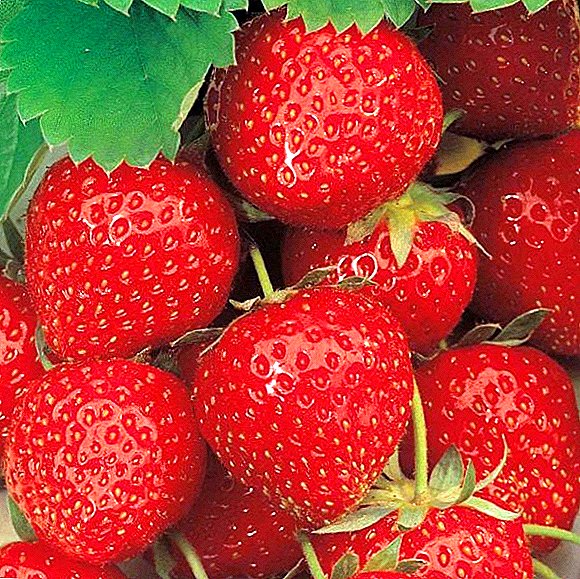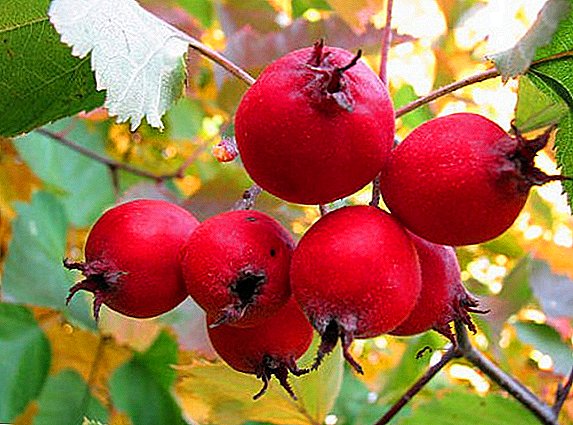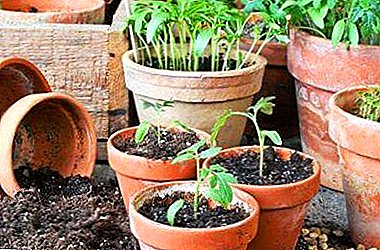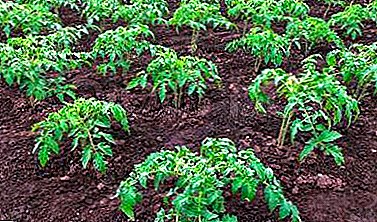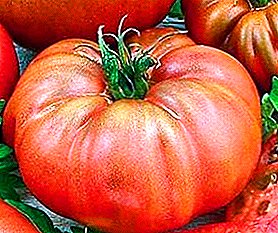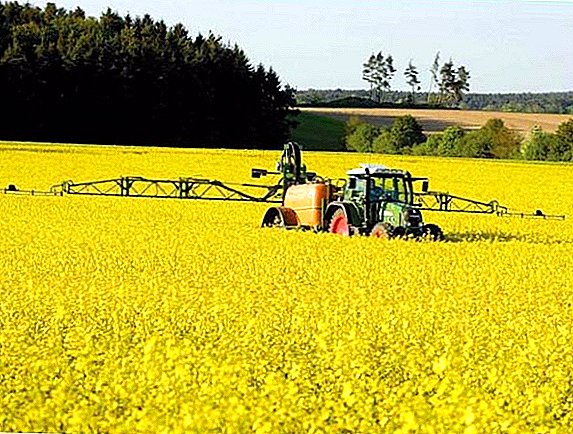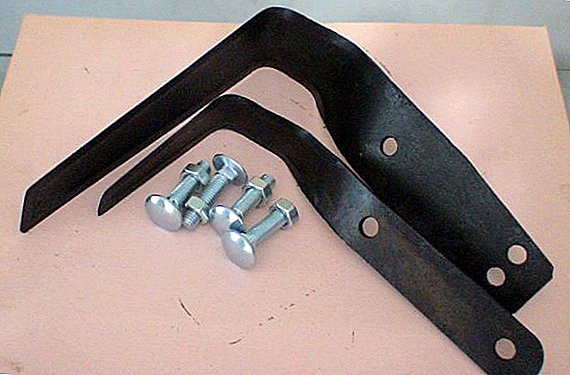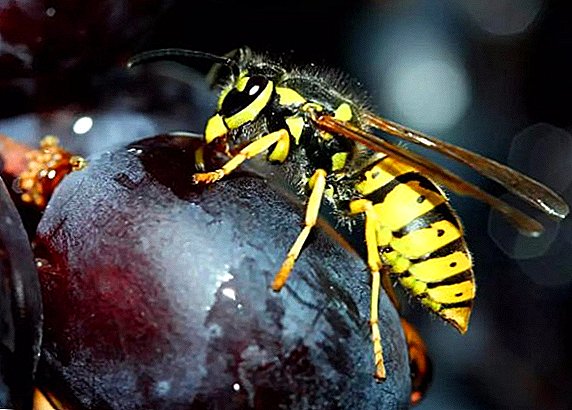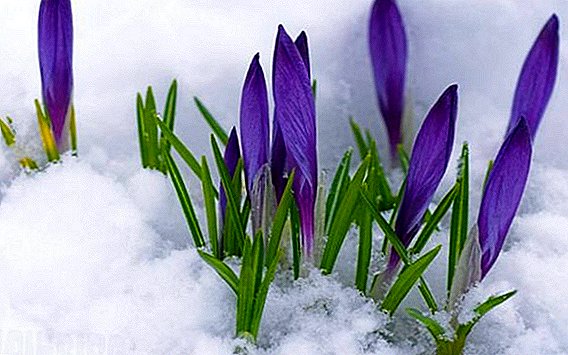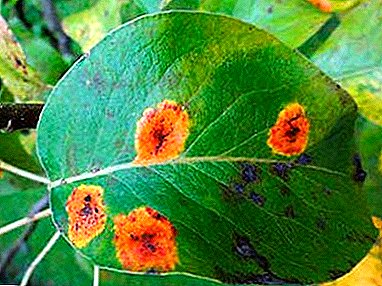
Rust - This is the most common disease of the leaves, from which the whole pear suffers.
Harm to a tree, it brings a very substantial and can affect not only a pear, but also an apple tree, quince and many other fruit crops.
The appearance of rust is very easy to notice. It is important to find out the foci of leaf disease in time and start the rust treatment, then the pear and the crop will be saved, and the rust will be defeated.
If you are faced with such a disease as rust on a pear and do not know what treatment is necessary for the disease, then in this article you will find what control measures you need to take than to heal and spray.
What is pear rust?

Rust pear disease - This is a fungus spreading spores, treatment and control of them is very difficult, in the article you will see photos of this disease on the leaves.
It mainly affects the leaves, but sometimes the shoots and even the fruit of the pear. The main the carrier of this disease is juniper. Always he is the first to suffer from rust.
On juniper, rust appears in the form of yellowed swollen twigs, in which the harmful fungus multiplies.
The ideal option for a pear would be the absence of a number of juniper bushes, then rust is not terrible.
But this is not always the case, because juniper can grow in the neighboring area. Next you will see pictures of the disease of the pear "rust" - this will help to recognize the disease by external signs.
A photo






How to recognize the danger in time?
Symptoms
The first signs of the disease appear on the leaves of the pear already in the end of April. On the top of the leaves, small orange-red spots appear with a yellow border.
They quickly grow, darken and become covered with gray stains resembling mold. Over time, if the disease is not treated, appear on the back of the leaves rusty growths, in the form of small conical needles.
They contain spores of the fungus, which re-infect juniper and all the apples and pears growing nearby.
The affected leaves dry out and soon fall off.
 A tree devoid of leaves is very weak; reduced immunityand if not to take action in time, it ceases to bear fruit and may even die.
A tree devoid of leaves is very weak; reduced immunityand if not to take action in time, it ceases to bear fruit and may even die.
Sometimes rust affects the shoots, branches and fruit of the pear. Strongly affected shoots cease to grow, thicken, become covered with red and yellow spots and dry out.
With a weak defeat, the bark on the branches and the trunk cracks. How can you help pear?
Treatment
Many gardeners, after finding a disease on a pear in their garden, are looking for answers to the questions: What measures to combat? How to treat and spray?
Immediately you can answer that getting rid of the disease of pear such as rust is very difficult, but here you will find all the tips and methods of struggle.
First thing removed and burned all affected leaves and branches.
All fallen leaves are also burned, and the ground around the plant is carefully dug up. It is desirable to process all sections with 1% copper sulphate.
Juniper begin to spray in early spring, with the help of a special preparation: Saprole (triforin). Conduct such treatments every 7-9 days.
Pear diseases such as scab, rust, powdery mildew are treated with systemic fungicides.
Pear treatment from rust in the fall after the leaves fall completely or in spring, before the buds begin to swell, is carried out with a 5% solution of urea by spraying.
 Fungicides process pear regularly, at least 4-5 times per season.
Fungicides process pear regularly, at least 4-5 times per season.
The first treatment with any drug spend to the swelling of the kidneys.
In early spring, the tree can be treated with 1% Bordeaux mixture or copper oxychloride.
This treatment is best done at an established positive temperature in cool and dry weather.
The second spraying is carried out at the very beginning of flowering, the third - immediately after, the fourth - after another 10 days.
Good help in the fight against rust such drugs:
Kuproksat (copper sulfate) is used at least 4 times a year, as well as Bordeaux mixture (50 ml per bucket of water).
Colloidal sulfur is applied 5 times per season: before leaflets, before flowering, after flowering, during the formation of fruits and after leaf fall (40 grams per bucket of water).
Poliram also copes with signs of rust. The treatment is carried out at least 4 times.
First - at the beginning of the swelling of the kidneys, the second - in the formation of buds, the third - after flowering, and fourth - on small emerging fruits.
In this case, the last spraying should be carried out no earlier than 2 months before harvesting (2 grams per bucket of water).
Is fast is a universal fungicide that helps to get rid of not only rust, but also scab and other unpleasant diseases of the pear. They are processed at least 3 times a year: before leaflets, before flowering and after. This drug is effective for 20 days (2 ml per bucket of water).
 Bayleton (triadimefon) - A good healing fungicide, used about 5-6 times per season (10 grams per bucket of water).
Bayleton (triadimefon) - A good healing fungicide, used about 5-6 times per season (10 grams per bucket of water).
First processing preferably carried out at the first sign of illness. Second one and subsequent, with an interval of 2-4 weeks.
At the very beginning of March all the affected shoots and branches are cut, capturing 5-10 cm of healthy tissue.
Tools for trimming should be thoroughly wiped with alcohol, and the cut points should be treated with copper sulphate and covered up with brew.
In the autumn, after the fall of all the leaves, always well spray the pear with a strong urea solution (700 g per bucket of water).
The soil around the tree is constantly loosened, weeded and dug for the winter. Do not forget about the timely introduction of phosphate-potassium fertilizers and regular cleaning of fallen leaves. But from the use of nitrogen fertilizers is better to refrain. If there is such an opportunity, it is better to remove the juniper growing nearby, or try to protect the pear from it.
Some gardeners use folk remedies in rust treatment. Such as an infusion of wood ash (500 grams per bucket of water) and an infusion of slurry. However, such methods do not bring tangible results, and are suitable only as preventive measures.
Learn about other diseases that you can find in your garden: //selo.guru/ptitsa/bolezni-p/gribkovye/parsha.html, Bacterial Grape Cancer, Anthracnose, Chlorosis, Bacteriosis, Bacterial Burn of a Pear.
Prevention
 The most important point in protecting a tree from rust is placement of pear seedlings as far as possible from any coniferous plantings.
The most important point in protecting a tree from rust is placement of pear seedlings as far as possible from any coniferous plantings.
If this is not possible, the pear is separated from them using a high hedge or a special screen.
Always need timely pear pruning. To clean fallen leaves, cultivate the soil around the tree.
Preventive spraying is carried out with 1% Bordeaux mixture or any copper-containing preparation at least 3 times per season.
First processing carried out before the first leaves, the second - after flowering and, after 12-14 days - the third. If the pear is not resistant to scab and is regularly treated against this disease, then no additional spraying against rust is carried out.
When the first signs of rust appear on a growing juniper row, it is also carefully treated and all damaged branches are pruned.
Resistant varieties
Among the summer varieties of pear resistant to rust: Rapidly, Williams, Ilyinka, Sugar, Bere Giffard, Chizhovskaya.
From resistant autumn varieties can be noted: Bere Bosk, Autumn Deck, Borovinka Red.
Winter varieties are rarely affected by rust: Bere Liguel, Belarusian late, Yakovlevskaya, Nika.
 In order to prevent the appearance of rust on the site, it is important to observe certain conditions: protect the pear from the neighborhood with juniper or other conifers, regularly prune and fertilize the tree, process it with fungicides for prevention.
In order to prevent the appearance of rust on the site, it is important to observe certain conditions: protect the pear from the neighborhood with juniper or other conifers, regularly prune and fertilize the tree, process it with fungicides for prevention.
With proper care and timely protection of the tree, rust damage can be avoided. Any disease is better to prevent than to cure. And in the case of rust - even more so.
Dealing with it is very difficult., and even after complete healing of the tree, it continues to be vigorously processed for several more years.
Watch the video about rust on pear.


